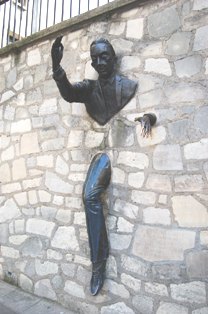In a small, secretive little plaza in the Montmartre district of Paris can be found a life-sized statue that is known to many native French, but is little known elsewhere. It is an unusual statue, nothing like the men on horseback or head-and-shoulders busts that usually grace the squares of ancient cities like Paris, nor is it some newfangled abstract artwork so common in American plazas. Rather, this statue is of a man who appears to be coming out of the supporting wall of the garden that lies above it. He is Dutilleul, a mousy, non-descript sort of man, a person most people observe and easily dismiss as unimportant. He is balding and ugly, the type of man who keeps mostly to himself in the workplace.
And yet, this man is not ordinary. He is passing through a wall. No one of my acquaintances can do that, and as we all know, this is the stuff only of science fiction.
The statue, sculpted by the famous French actor Jean Marais (1913-1998), was produced to commemorate the most famous story of author Marcel Aymé (1902-1967), “Le Paisse-Muraille” or “The Man Who Could Walk Through Walls.” Published in 1943 and twice turned into a film, the story is about one Dutilleul, a humble civil servant. One day, upon being locked out of his home, Dutilleul discovers he has the unique ability to walk through walls. But “this strange ability seemed to have no bearing on any of his aspirations, and he could not help feeling rather vexed about it.” And so Leon goes to see a doctor for a cure to his “ailment.” The doctor prescribes two pills for the hapless Dutilleul: one to be taken immediately, and the other before the year is out. He dutifully takes the first pill and hides the other in a desk drawer for taking later. And so Dutilleul goes on with his life, enjoying the simple pleasures of his stamp collection and reading the newspaper, never using his strange ability. An ability which he will retain until after he swallows the second pill.
But then something happens which causes Dutilleul to use his power. He gets a new boss, a man who desires to reform the office, even down to the smallest detail, such as how letters are to be addressed. This is too much for Dutilleul, who had always done things one way for twenty years, and he begins to use his ability to play pranks on his boss, slowly driving him mad. Dutilleul likes this, and begins to see that the ability he once scorned can actually be rather fun. He soon turns to a life of crime, using his ability to walk through walls to perform burglaries under the name of “The Lone Wolf.”
But he soon tires of this, and while walking in the Rue Lepic (not far from where the statue is today) he encounters a beautiful woman with whom he falls instantly in love. But she is married. Of course, that is no bar for a man who can walk through walls, and the woman and Dutilleul manage to meet. But the next day, Dutilleul finds he has a headache, and so takes a pill he pulls from his desk. He then heads to his planned rendezvous with the woman he met in the Rue Lepic. When Dutilleul left her, he has some small trouble getting through the wall, but thinks little of it. It is not until he is halfway through the garden wall that he realizes he can go not further. Apparently what he had thought was an aspirin tablet was in fact the second pill which would cure him of his “ailment.” And so there he remains to this day, trapped half in and half out of the garden wall.
For me, this encounter with the man who walks through walls was an unexpected pleasure. Here I was, on a field trip with a bunch of homeschoolers, studying the art and architecture of the ancient city of Paris and all of a sudden we turn a corner and encounter a piece of art that is wholly science fiction in content. Sure, it is a simple statue, nothing unusual in that, but its choice of subject makes it stand out to this unabashed SF fan. Even more poignant is the fact that Montmartre is the very district where the great artists like Toulouse-Latrec, Van Gogh, Matisse, Monet and Picasso lived and worked at one time or another. Why did this have such an effect on me? Well, simply because in the city of artists stands a monument to a work of science fiction. It is an uncomplicated work, not having anything in it to merit extremely high praise. But it is a piece of SF history, and one little known. It was therefore a surprise and a pleasure to see my favorite genre getting some small recognition in this city which has produced so many great artists.
After my encounter with the man who walked through walls, I did some digging found an English translation of “Le Passe-Muraille” online. Although it is not an exceptional translation, the reader can see why Jean Marais was affected enough to produce this sculpture. The statue serves as a reminder that science fiction has a longer history and wider popularity then we often give it credit for.
If you are ever in Paris, make it a point to go and see the statue of Dutilleul at the Place Marcel Aymé, Montmartre. It is a little slice of science fiction history.










